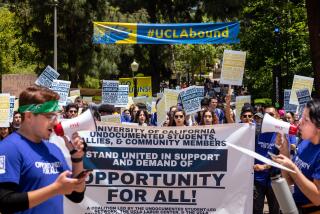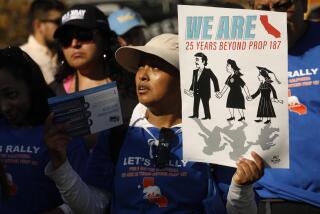Searching for Solutions
The conceit of newspaper editorials is certainty. The anonymous author speaks for an institution, and the institution has it all figured out. But on some big issues it is said, and said truly, that there are “no easy answers.” Healthcare is one. Traffic is another. Immigration is a third. These are issues that affect us all as individuals, and require decisions from us as a society. Yet every avenue toward a solution hits a dead end. Clashing interests, or simple mathematics, block the way.
Unfortunately, the lack of acceptable answers doesn’t make the issues go away. If nothing is done, matters will almost certainly get worse. So at least one alternative cannot accurately be called unacceptable because it will have to be accepted. Or, to make the point more positively, even if there are no good alternatives, there is always a best alternative.
Two of the three issues mentioned above -- traffic and immigration -- resonate especially for Southern Californians. On both, this newspaper’s opinion pages (the editorial and Op-Ed pages and the Sunday Opinion section) have begun a process we label “Thinking Out Loud.” Rather than pretending to be certain now, or copping out by saying that certainty is impossible, we intend to share with our readers -- through editorials, signed essays, letters and interactive features on the Web -- the process of figuring out that best solution.
The immigration issue flows into and out of the political debate in cycles measured in decades. California was embroiled in a political civil war over illegal immigration in 1994, and the country last underwent a substantial reform of its immigration laws in 1996. Now it is heating up again.
It’s hard to come up with a single, coherent position on immigration because it touches on our national life and our individual lives in so many different ways. The tensions this creates and the trade-offs it requires are familiar, but that doesn’t make them any easier to resolve. But these subissues can at least be classified under two large headings: (1) Of the masses already huddled here illegally or still in their home countries longing to make new lives in the United States, how many should we allow to stay and how many more should we allow to come in? And (2) what should we do -- and not do -- to enforce whatever answer we come to under heading No. 1?
America’s current immigration policy is, in essence, to resolve all contradictions by ignoring them. We set rules, and then we don’t enforce them. Not just in states along the southern border, we are deeply dependent on the labor of people we forbid to enter this country legally. Mexicans and others approaching that border are confronted with two signs. One says, “Help Wanted: Inquire Within.” The other says, “No Trespassing.”
Ambiguity or even hypocrisy is not always a bad policy, but relying on a blatantly illegal arrangement to meet the country’s demand for labor is a bad idea. It’s not just bad immigration or labor policy; it’s a form of cancer afflicting our democracy’s rule of law.
For the United States, unlike most other nations, immigration is central to the national myth -- our sense of who we are. We are not united by ethnicity, but by the choice made to come here. And the myth reflects reality, though of course it’s only part of the story. The Indians were already here, and the forebears of most African Americans did not come here by choice. But most of us are immigrants, or children or grandchildren of immigrants. What will it do to our national myth for most of tomorrow’s sons and daughters of immigrants to be the children of people who committed a crime in coming here?
And our parents or grandparents, or we ourselves, most likely came here for roughly the same mixture of motives -- economic and political, practical and spiritual -- that brings would-be Americans here today. That makes it hard -- or should make it hard -- to say: “We’re in. Now shut the door.” But can we say, as America did when most of our ancestors arrived, “Open the door -- come on in”? Most Americans believe that is no longer practical.
Some people even challenge the sacred notion that there are no easy answers to the immigration puzzle. Three easy answers float around this debate:
* Open the door. Unlimited immigration has been a huge plus for our country, and there is no reason to think that won’t continue.
* Shut the door. This isn’t the 19th century. America is full.
* Illegal immigration is bad, legal immigration is good.
If only it were that easy. But there are too many real-life complications for an absolutist policy at either extreme to work. And the distinction between legal and illegal immigrants assumes away most of the problem. The problem is figuring out who should be legal in the first place.
We don’t know where our journey of intellectual discovery about immigration will end. We know, or hope we know, when it will end: in about six months.


